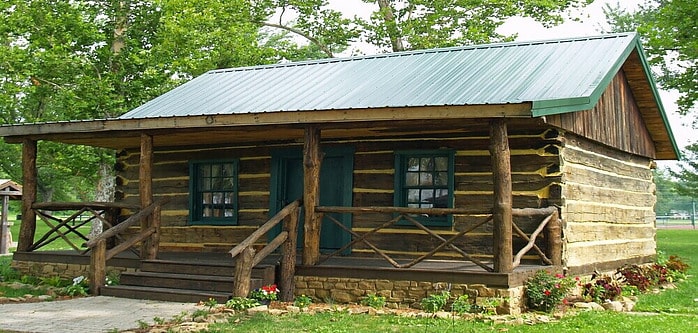Affiliate Disclosure: I earn commissions if you shop through the links below at no additional cost to you.
Last Updated on January 13, 2024 by Jeremy
I’m drawn to the serene charm of log cabin living, the kind of allure that speaks of cozy evenings by the fire and quiet mornings with nature at your doorstep. Imagine crafting such a haven with your hands. It’s a dream many share, and I’m here to guide you on how to build your own log cabin, and turn that dream into your very own reality.
Building a log cabin is more than just the assembly of logs; it’s embracing a lifestyle, a return to simpler times, and a testament to personal achievement. This endeavor requires planning, perseverance, and a passion for the DIY spirit.
Why embark on this journey? Constructing your own log cabin comes with substantial benefits. There’s the satisfaction of creating something tangible and the customization of your living space to meet your needs and reflect your taste. Moreover, there’s the potential for cost savings compared to purchasing a pre-built home, not to mention the environmental benefits of using natural, renewable resources.
Yet, before collecting your tools and donning your work gloves, it’s critical to understand the process that lies ahead. From sketching the first lines of your blueprint to laying the last log, every step should be thoughtfully planned and meticulously executed.

In the next section, ‘Designing Your Log Cabin: Blueprints to Reality,’ I’ll guide you through the essential first stage: design. Here, you’ll learn about factoring in everything from sunlight to sustainability, which sets the tone for every log that follows. So, grab your notepad, and let’s set the foundation for a cabin that’s not just built, but thoughtfully designed to be a part of your life for years to come.
Designing Your Log Cabin: Blueprints to Reality
When I dream of my log cabin, it’s not just a dwelling but a personal retreat that resonates with my style and needs. To turn this dream into reality starts with a well-thought-out design. Crafting a blueprint isn’t just about aesthetics; it reflects our anticipated lifestyle and daily activities within its wooden embrace.
Choosing the right location for your log cabin is vital. The ideal spot isn’t only about the view; it should consider exposure to natural light, wind directions, and even the slope of the land. Orientation plays a significant role in energy efficiency; a south-facing position, for example, can harness the sun’s warmth during colder months.
Incorporating energy efficiency and sustainability from the beginning isn’t just good for the planet; it’s smart economics. Features like solar panels, a rainwater harvesting system, or an eco-friendly sewage treatment facility reduce long-term costs and your cabin’s carbon footprint. Strategizing for these elements in the design phase makes them far easier to implement.

Legal Framework: Navigating Zoning and Permits
Before laying the first log of your dream cabin, you must navigate the legalities of construction. Building a log cabin is no small feat, and it’s crucial to respect the laws and building codes designed to ensure safety and compliance with local standards. I must stress the importance of doing thorough homework on local zoning laws which vary extensively by location and can influence the size, appearance, and even specific construction materials of your cabin.
The steps to acquiring the necessary permits are sequential and meticulous. Begin by visiting your local zoning office to gather information. There, you’ll present your building plans and discuss your project. Don’t see this as red tape; it is a valuable process to verify that your plans are sound and safe. Engage proactively with the authorities; this positive relationship can facilitate a smoother building process.
Stressing the importance of obtaining all the required permits before construction starts, remember that failure to comply can lead to fines or a forced halt to your project. These permits are also critical for future considerations like insurance and resale value. Moreover, think of permits as a safeguard—they verify that your cabin will be a safe refuge for you and your family, whether off-grid in Canada or elsewhere.
With the legalities in order, you’ll probably feel a mixture of relief and excitement to move on to the next phase: preparing for construction. There’s a practical beauty in the anticipation of handpicking each log and tool. You’ll discover that the right materials and tools not only promise structural integrity but also an intrinsic satisfaction in the building process.

Materials and Tools: Preparing for Construction
Before you hammer the first nail or fit the first log, pause to consider your materials and tools. This is where your log cabin starts to take shape, far before it rises from the ground.
Selecting quality logs is critical. Look for straight, well-seasoned logs from a reputable supplier or, if you’re harvesting your own, ensure they come from healthy trees. Your choice in wood species affects not only the aesthetics but also the durability of your cabin.
Don’t overlook the importance of additional construction materials like fasteners, sealants, and roofing. Each plays a crucial role in the integrity of your cabin.
Gather the essential tools, some of which may already be in your toolkit: a chainsaw for shaping logs, a sledgehammer for driving stakes, and levels for alignment. For a more authentic experience, consider traditional hand tools like broad axes and adzes.
For the more intricate work, precise measuring tools and a spirit level are indispensable. These ensure logs align correctly, creating a secure and visually pleasing structure.
Consider environmental impact when sourcing materials. Where possible, choose local, sustainable options to minimize your cabin’s footprint.

Laying the Groundwork: Foundations for Stability
I begin with a fundamental truth about log cabin construction: the foundation impacts everything that comes after. A solid foundation ensures your log cabin stands the test of time, while a poor choice can lead to countless problems down the line. So, let’s talk about how to lay this crucial groundwork.
Choosing the right foundation starts with the soil. Test the soil to gauge its bearing capacity and frost line depth. These factors inform your decision on the type of foundation you’ll need, be it a full basement, crawlspace, or concrete piers.
A full basement provides extra living space but is pricier and more complex to construct. Crawlspaces offer a budget-friendly alternative that still allows for easy access to utilities. Concrete piers can be ideal for sloped sites and are less invasive to the site.
Now, the actual laying of the foundation requires precision. Follow these steps: outline the cabin’s footprint, excavate the site, pour footings, and construct the foundation wall or place the piers. Remember to consult with a structural engineer to ensure everything is up to code.
Water is an enemy for longevity. Therefore, waterproofing is critical. Using the right materials and techniques for sealing and drainage, like a waterproof membrane and foundation drainage tiles, can save you a lot of hassle in the future.
Finally, let the foundation set and cure properly before you begin any construction above ground. Rushing this stage can undermine the cabin’s integrity. The patience you exercise now will pay off for years to come.

Assembling Your Log Cabin: Techniques and Tips
The actual assembly of your log cabin is where your vision starts to take physical shape. There are a few popular methods for log cabin construction, each with its unique characteristics. The Scandinavian full-scribe method is renowned for its snug fit and natural aesthetics, while the piece-en-piece method allows for more flexibility in design.
Regardless of the approach, a fundamental aspect is ensuring a tight fit between logs. Scribing and notching logs might be the most time-consuming part of the build, but it’s critical for stability and insulation. You’ll want to pay special attention to the corners, as different notching techniques, like saddle-notch or dovetail, can influence both the look and the structural integrity of your cabin.
While the traditional methods of log cabin construction hold a certain appeal for their authenticity and handcrafted charm, modern building techniques can offer improvements in efficiency and precision. For instance, using a chainsaw for notching rather than traditional hand tools can save time without compromising quality, as long as you have the skill to wield it effectively.
As you finish assembling the cabin, ensure the structure is sound before moving onto installing the roof and windows. This phase sets the stage for adding the interior elements that will turn the rugged structure into a cozy home.

Interior Design and Insulation: Combining Comfort with Charm
Once the exterior of your log cabin stands sturdy and proud, attention shifts inside to where warmth and personality take center stage. Interior design in a log cabin holds its own unique challenges and opportunities. The choice between modern and rustic, or a blend of both, dictates the materials and color schemes. Rich, natural woods complemented by wrought iron, stone, or leather accents enhance the cabin’s organic ambiance.
However, an appealing aesthetic is nothing without comfort, which is critically anchored to insulation. Effective insulation is non-negotiable for year-round coziness. Log cabins particularly benefit from high-quality foam or fiberglass insulations. More eco-conscious builders might opt for sheep’s wool or cotton, which while potentially more expensive, offer excellent natural alternatives.
Insulation also extends to windows and doors, where energy loss commonly occurs. Double or triple-glazed windows and well-sealed doors are investments that pay off in both comfort and energy savings. Remember to factor in the local climate when choosing your insulation materials; what works in a mild climate can prove inadequate in more extreme conditions.
Now, let’s address the elephant in the room – maintaining the desired temperature. The fact is, wood itself is a natural insulator. However, managing airflow with strategic ventilation ensures that your log cabin can stay cool in the summer and retain heat in the winter.
Putting personality into your cabin is about more than just furniture. It’s about choosing light fixtures that cast a warm glow, selecting textiles that invite you to unwind, and finding the balance between functional space and cozy nooks. A well-thought-out interior not only suits your taste but also enhances the log structure, ensuring the cabin feels like a home.
With your log cabin’s interior poised for both style and substance, it’s essential to consider what comes next: the ongoing commitment to maintenance. Up next, we’ll talk about how to keep your log cabin in tip-top condition, making sure that the effort you’ve invested continues to pay dividends in comfort and durability.

Conclusion: A Cabin to Call Home
I’ve taken you through the meticulous steps to build a log cabin from the ground up, and now we reach the end of our journey together. Building a log cabin is more than construction; it’s about weaving your dreams into a structure that stands firmly amidst nature’s beauty. The dedication you’ve shown in crafting each log and driving every nail carries the echo of tradition and the warmth of personal touch.
As I look back on the foundational knowledge shared, from selecting materials to addressing the nitty-gritty of insulation, it’s clear that this endeavor is a blend of hard work and passion. There’s pride in knowing that the walls you raise are not just made of wood, but of your labor and love. You’ve established more than a dwelling; you’ve built a sanctuary that resonates with your spirit and values.
The log cabin you’ve created stands as a testament to your perseverance and skill. It is a legacy that can be passed down, a haven that wraps its sturdy arms around family and friends, providing shelter and solace. And when the day’s work is done, and you sit back to marvel at what your hands have wrought, remember that every beam holds a story, every corner, a memory.
Your log cabin is not just a retreat from the world; it is a part of your journey, reflecting your character, echoing your resilience. As you carry on with the upkeep, let it be a ritual that honors your commitment, a testament to the cabin’s enduring strength and beauty.

May your log cabin be a home filled with laughter, stories, and the warmth of countless fireside gatherings. May it be your comforting escape, a place where time slows down, inviting reflection and contentment. Embrace this achievement, and let your cabin be a space where life is lived well and every moment is cherished. Congratulations, master cabin builder, on a job superbly done.
Please make sure to comment on this article if you enjoyed it, share it if you know someone that would enjoy it, or follow us and subscribe on our YouTube channel!
Cheers!




.jpg/:/cr=t:5.56%25,l:0%25,w:100%25,h:88.89%25/rs=w:1240,h:620,cg:true)



Leave a Reply